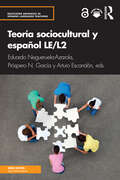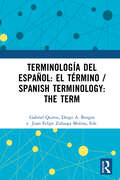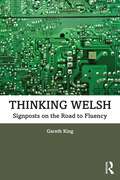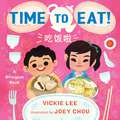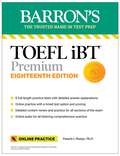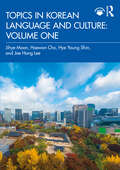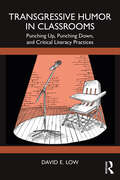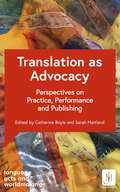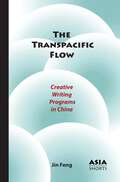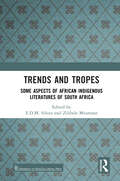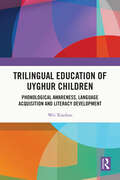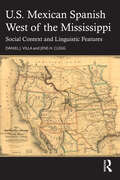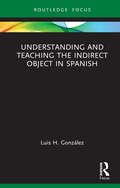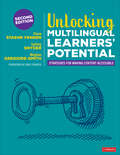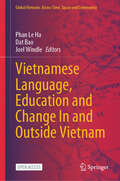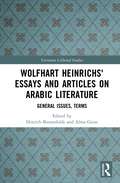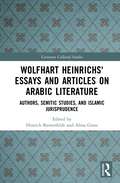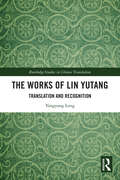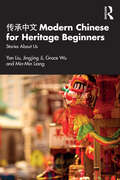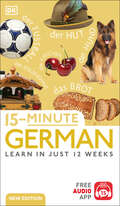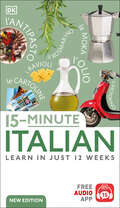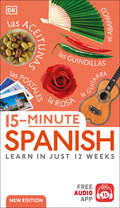- Table View
- List View
Teoría sociocultural y español LE/L2 (Routledge Advances in Spanish Language Teaching)
by Eduardo Negueruela-Azarola Próspero N. García Arturo EscandónTeoría sociocultural y español LE/L2 es una introducción académica a conceptos clave de la teoría sociocultural aplicada a la enseñanza y el aprendizaje de español como segunda lengua y lengua extranjera. Los capítulos han sido escritos por expertos de todo el mundo, tanto por investigadores y profesores de larga trayectoria como por nuevos investigadores. La obra ofrece una revisión detallada del impacto de las ideas socioculturales en la enseñanza y aprendizaje de español.Es el primer libro que se publica en español con este enfoque. En sus páginas se documenta la transformación que el enfoque sociocultural está produciendo en la enseñanza-aprendizaje de segundas lenguas, en su investigación y evaluación, y en la formación docente. La obra concibe el aprendizaje y el desarrollo como actividades socioculturales e interpersonales, y destaca el objetivo de la evaluación y de la investigación como herramientas de intervención dinámica para el aprendizaje y crecimiento y, finalmente, cómo un enfoque sociocultural ilumina la importancia de la mediación en los procesos de aprendizaje y desarrollo de la persona.El volumen tiene las siguientes características: Incluye una entrevista con James P. Lantolf, uno de los investigadores más prominentes de la teoría sociocultural aplicada a las segundas lenguas Un uso consistente de la terminología de la teoría sociocultural en español a lo largo de toda la obra Cada capítulo tiene una estructura homogénea, lo cual facilita su consulta No reproduce la literatura existente en inglés, sino que desarrolla propuestas teóricas y de investigación propias y novedosas Incluye un glosario, disponible en línea, de términos relevantes en la teoría sociocultural con breves definiciones Diseñado y pensado para aquellos sin conocimientos previos de la teoría, Teoría sociocultural y español LE/L2 ofrece explicaciones claras y accesibles sobre la TSC acompañadas de ejemplos concretos y aplicaciones prácticas para la clase de lenguas. Es un recurso esencial para cualquiera que enseñe español LE/L2, así como para quienes investiguen su adquisición.Chapter 4 of this book is freely available as a downloadable Open Access PDF at http://www.taylorfrancis.com under a Creative Commons Attribution-Non Commercial-No Derivatives (CC-BY-NC-ND) 4.0 license.Teoría sociocultural y español LE/L2 introduces the key concepts of sociocultural theory (SCT) as they apply to the teaching and acquisition of Spanish as a second and foreign language. Contributions from leading experts from across the globe, both well-established and emerging scholars, offer an in-depth view of how a sociocultural approach can impact the teaching and learning of Spanish.The first book on this subject to be written in Spanish, this unique volume examines the transformation that sociocultural ideas are producing and conceives learning and development as sociocultural and interpersonal activities. It highlights the objective of evaluation and research as dynamic intervention tools for learning and growth, the active role learners must play, and how a sociocultural approach illuminates the importance of mediation in the learning and development processes of the individual.Key features include: An interview with James P. Lantolf, one of the most prominent researchers in SCT applied to second languages A consistent use of sociocultural theory terminology in Spanish throughout A homogeneous chapter structure which makes it easy to consult Its own newly developed theoretical and research proposals An online glossary of relevant terms in sociocultural theory with brief definitions Designed for those with no prior knowledge of the subject area, Teoría sociocultural y español LE/L2 provides straightforward and accessible explanations of SCT accompanied by specific and practical applications for the language classroom. It is an essential resource for anyone
Terminología del español: el término / Spanish Terminology: The Term
by Gabriel Quiroz Diego A. Burgos Juan Felipe Zuluaga MolinaTerminología del español: el término / Spanish Terminology: The Term provides a consolidated and research-based guide to Terminology Science in Spanish. This edited collection brings together experts in the field who draw upon a large-scale, multi-subject terminology and corpus linguistics research project to provide data, examples, trends, models, analysis, and discussion of terms.Readers will find this a practical guide to term characterization that can be applied to tasks and processes related to terminology, term extraction, specialized translation, knowledge representation, and language for specific purposes. Nine of the 13 chapters focus on a specialized category ranging from terminological nouns and verbs to complex terms and specialized phraseology and offers a qualitative characterization of the relevant category, as well as a quantitative insight into the category trends in a representative corpus of specialized discourses in Spanish. The volume also includes chapters on the teaching of terminology, term extraction, the methodology of terminological projects, and a quantum theory of the term.This volume will be of interest to specialists in Terminology, Spanish linguistics, technology-mediated language processing, specialized translation, specialized lexicography, and language for specific purposes.Terminología del español: el término / Spanish Terminology: The Term constituye una guía comprensiva y basada en investigación sobre la Terminología en español. Este volumen editado reúne a expertos en el campo, los cuales se basan en un proyecto de investigación multidisciplinario y representativo en terminología y lingüística de corpus para mostrar datos, ejemplos, tendencias, modelos, análisis y discusión de diversos términos.Los lectores encontrarán en este libro una guía práctica para la caracterización de términos, lo cual se puede aplicar a tareas y procesos relacionados con la terminología, la extracción de términos, la traducción especializada, la representación del conocimiento y el lenguaje con fines específicos, entre otros. Nueve de los 13 capítulos se centran en una categoría especializada que va desde sustantivos y verbos terminológicos hasta términos complejos y fraseología especializada, y ofrecen una caracterización cualitativa de la categoría relevante, así como una perspectiva cuantitativa sobre las tendencias de la categoría en un corpus representativo de discursos especializados en español. El volumen también incluye un capítulo que propone una teoría cuántica del término, así como tres capítulos adicionales dedicados a la enseñanza de la terminología, la extracción de términos y la metodología de proyectos terminológicos.El volumen será de interés para especialistas en Terminología, lingüística española, procesamiento del lenguaje mediado por tecnologías, traducción especializada, lexicografía especializada y lenguas con fines específicos.
Thinking Welsh: Signposts on the Road to Fluency
by Gareth KingThinking Welsh focuses on how common English words, phrases and constructions map onto Welsh, and highlights the key areas of difference and difficulty in these mapping operations. 150 English words and grammatical and communicative concepts are listed alphabetically, explained in clear and accessible language, and given ample exemplification to illustrate their meaning and use. All instances of mutation are marked with the usual typographic signs, and cross-references are given throughout to related entries. A list of essential grammatical terms and a Welsh index round off the manual. Thinking Welsh is a ground-breaking resource for post-beginner students wishing to explore lexical issues and master key syntactic structures as a way of attaining fluency of expression and comprehension in modern spoken and standard Welsh.
Time to Eat!
by Vickie LeeSparse text and bright illustrations help readers learn the names of all of their favorite dishes in both English and Mandarin. From spare ribs to spring pea shoots there's something for everyone in this timeless story about dinner time.
TOEFL iBT Premium with 8 Online Practice Tests + Online Audio, Eighteenth Edition (Barron's Test Prep)
by Pamela J. Sharpe Ph.D.Barron&’s newest edition of TOEFL iBT has been fully updated to reflect the new TOEFL format and provides flexible study options and key skills review to help you study what you need to know for the test. This edition includes: 8 full-length TOEFL iBT practice tests that reflect the most recent test format with answer explanations Comprehensive review of required academic and language skills Four video lessons on the key skills needed to succeed on the TOEFL: Note Taking, Paraphrasing, Summarizing, and Synthesis Grammar review that supports the Speaking and Writing Sections Online audio for all listening prompts
Topics in Korean Language and Culture: Volume One
by Jihye Moon Haewon Cho Hye Young Shin Jae Hong LeeTopics in Korean Language and Culture: Volume One covers 12 essential topics relating to both traditional and contemporary Korean culture and society.Each chapter consists of listening and reading passages, key expressions and grammar, and performance-based activities unfolding across different modes of oral and written communication. The grammar section is organized into foundation review, semantic distinction, and language function to help learners advance beyond the plateau of intermediate proficiency. All passages are carefully written to resemble authentic texts used by Korean native speakers and to include various text types and speech styles that learners will encounter in real life.The first volume specifically targets students in their third year of learning Korean. It is designed to accommodate a wide range of courses and curricula existing for Korean programs today. It is intended for a yearlong language sequence as well as an intensive topic course in speaking, reading, or writing.
Transgressive Humor in Classrooms: Punching Up, Punching Down, and Critical Literacy Practices
by David E. LowIn this innovative book, David E. Low examines the multifaceted role of humor in critical literacy studies. Talking about how teachers and students negotiate understandings of humor and social critique vis-à-vis school-based critical literacy curriculums, the book co-examines teachers’ and students’ understandings of humor and critique in schools.Critical literacy centers discussions on power and social roles but often overlooks how students use transgressive humor as a means to interrogate power. Through examples of classroom interactions and anecdotes, Low analyzes the role of humor in classroom settings to uncover how humor interplays with critical inquiry, sensemaking, and nonsense-making. Articulated across the fields of literacy studies and humor studies, the book uses ethnographic data from three Central California high schools to establish linkages and dissonances between critical literacy education and adolescents’ joking practices. Adopting the dialectic of punching up and punching down as a conceptual framework, the book argues that developing more nuanced understandings of transgressive humor presents educators with opportunities to cultivate deeper critical literacy pedagogies and that doing so is a matter of social justice.Essential for scholars and students in literacy education, this book adds to the scholarship on critical literacy by exploring the subversive power of humor in the classroom.
Translation as Advocacy: Perspectives on Practice, Performance and Publishing (Language Acts and Worldmaking)
by VariousWhat does it mean to advocate - in translation, for translation, through translation? What does advocacy look like, for those who do the translating or for those whose work is translated? To what extent is translation itself a form of advocacy? These 'what' questions are the driving force behind this collection.Translation as Advocacy highlights the innovative ways in which translator-academics in seven different fields discuss their practice in relation to their understanding of advocacy. The book aims to encourage people to think about translators as active agents bringing new work into the receiving culture, advocating for the writers they translate, for ideas, for practices. As such, the book asserts that the act of translation is a mode of cultural production and a political intervention through which the translator, as advocate, claims a significant position in intercultural dialogue.Featuring seven interrelated chapters, the book covers themes of judgement, spaces for translation, classroom practice, collaboration, intercultural position, textuality, and voice. Each chapter explores the specific demands of different types of translation work, the specific role of each stage of the process and what advocacy means at each of these stages, for example: choosing what is translated; mediating between author and receiving culture; pitching to publishers; social interactions; framing the translation for different audiences; teaching; creating new canons; gatekeepers and prizes; dissemination; marketing and reception. This book repositions the role of the translator-academic as an activist who uses their knowledge and understanding to bring agency to the complex processes of understanding across time and space. Moving critically through the different stages that the translator-academic occupies, using the spaces for research, performance and classroom teaching as springboards for active engagement with the key preoccupations of our times, this book will highlight translation as advocacy for students, educators, audiences for translation and the translation industry.Like all the volumes in the Language Acts and Worldmaking series, the overall aim is two-fold: to challenge widely-held views about language learning as a neutral instrument of globalisation and to innovate and transform language research, teaching and learning, together with Modern Languages as an academic discipline, by foregrounding its unique form of cognition and critical engagement.Specific aims are to:· propose new ways of bridging the gaps between those who teach and research languages and those who learn and use them in everyday contexts from the professional to the personal· put research into the hands of wider audiences· share a philosophy, policy and practice of language teaching and learning which turns research into action· provide the research, experience and data to enable informed debates on current issues and attitudes in language learning, teaching and research· share knowledge across and within all levels and experiences of language learning and teaching· showcase exciting new work that derives from different types of community activity and is of practical relevance to its audiences· disseminate new research in languages that engages with diverse communities of language practitioners.
Translation as Advocacy: Perspectives on Practice, Performance and Publishing (Language Acts and Worldmaking)
by VariousWhat does it mean to advocate - in translation, for translation, through translation? What does advocacy look like, for those who do the translating or for those whose work is translated? To what extent is translation itself a form of advocacy? These 'what' questions are the driving force behind this collection.Translation as Advocacy highlights the innovative ways in which translator-academics in seven different fields discuss their practice in relation to their understanding of advocacy. The book aims to encourage people to think about translators as active agents bringing new work into the receiving culture, advocating for the writers they translate, for ideas, for practices. As such, the book asserts that the act of translation is a mode of cultural production and a political intervention through which the translator, as advocate, claims a significant position in intercultural dialogue.Featuring seven interrelated chapters, the book covers themes of judgement, spaces for translation, classroom practice, collaboration, intercultural position, textuality, and voice. Each chapter explores the specific demands of different types of translation work, the specific role of each stage of the process and what advocacy means at each of these stages, for example: choosing what is translated; mediating between author and receiving culture; pitching to publishers; social interactions; framing the translation for different audiences; teaching; creating new canons; gatekeepers and prizes; dissemination; marketing and reception. This book repositions the role of the translator-academic as an activist who uses their knowledge and understanding to bring agency to the complex processes of understanding across time and space. Moving critically through the different stages that the translator-academic occupies, using the spaces for research, performance and classroom teaching as springboards for active engagement with the key preoccupations of our times, this book will highlight translation as advocacy for students, educators, audiences for translation and the translation industry.Like all the volumes in the Language Acts and Worldmaking series, the overall aim is two-fold: to challenge widely-held views about language learning as a neutral instrument of globalisation and to innovate and transform language research, teaching and learning, together with Modern Languages as an academic discipline, by foregrounding its unique form of cognition and critical engagement.Specific aims are to:· propose new ways of bridging the gaps between those who teach and research languages and those who learn and use them in everyday contexts from the professional to the personal· put research into the hands of wider audiences· share a philosophy, policy and practice of language teaching and learning which turns research into action· provide the research, experience and data to enable informed debates on current issues and attitudes in language learning, teaching and research· share knowledge across and within all levels and experiences of language learning and teaching· showcase exciting new work that derives from different types of community activity and is of practical relevance to its audiences· disseminate new research in languages that engages with diverse communities of language practitioners.
The Transpacific Flow: Creative Writing Programs in China (Asia Shorts)
by Jin FengWhat happens when a US cultural institution is imported to China, the purported chief rival of the United States in the twenty-first century? The first book-length account of university-based creative writing programs in China, this book reveals how Chinese intellectuals adapt American-style writing programs such as the Iowa Writers’ Workshop and the International Writing Program at Chinese universities to seek agency and literary innovation in the last two decades. The rise of creative writing programs in China explains broader issues of cultural production in an increasingly authoritarian and market-oriented postsocialist state. By telling a unique story of Chinese intellectuals’ interactions with an influential Western cultural institution, this book also shows how varied cultural and geopolitical priorities can rewrite the story of the global influence of the United States.
Trends And Tropes: Some Aspects of African Indigenous Literatures of South Africa
by E.D.M. Sibiya Zilibele MtumaneThis collection explores topical and current issues in indigenous African language literature of South Africa. These include narratological elements of literature, language usage, poetry analysis, and song lyrics. Each scholar presents findings that are particular to their research, thus making the book a valuable source of knowledge penned in a diversity of writing styles across different literary genres.Seventy per cent of the chapters are written in English and thirty per cent in isiZulu, a gesture towards encouraging research presentations in indigenous languages. Also of interest is that the chapter content covers traditional or largely obsolete forms such as folklore and essays.Print edition not for sale in Sub Saharan Africa.
Trilingual Education of Uyghur Children: Phonological Awareness, Language Acquisition and Literacy Development
by Wei XiaobaoGiven the differences in the orthographic structure of the Uyghur, Chinese and English languages, this study used a mixed-method approach to systematically describe and analyze the phonological awareness of Uyghur bilingual children as English learners and its contributions to their trilingual literacy acquisition and development.Focusing on the development of these learners' phonological awareness in Uyghur, Chinese and English, this study explored the influences of Uyghur and Chinese learning on the formation of their English phonological awareness and the roles of different components of phonological awareness in their trilingual literacy development. Based on the characteristics of the phonetic structure in Uyghur, Chinese and English and the development of Uyghur children's phonological awareness in these languages, a Chinese phonetic identification training and Uyghur–Chinese–English comprehensive phonetic training program (including intensive phoneme category contrast training and phonics training) was designed to explore whether such targeted phonetic identification training can effectively improve these children's phonological awareness in Chinese and English and thus further promote their trilingual literacy development.This book will appeal to researchers and students interested in the fields of psycholinguistics, language acquisition and multilingual education.
U.S. Mexican Spanish West of the Mississippi: Social Context and Linguistic Features
by Daniel J. Villa Jens H. CleggU.S. Mexican Spanish West of the Mississippi proposes a macro-dialect of the most widely spoken Spanish variety in the western United States from a number of social and linguistic angles. This book is unique in its focus on this one variety of Spanish, which allows for a closer investigation of the social context and linguistic features through a number of different topics. Comprised of 13 chapters divided into two sections, this textbook provides insight into the history, demographics, migration, and social issues of US Mexican Spanish in the first section and its lexicography, phonology, and structure in the second. Useful for scholars interested in Spanish in the United States, dialectology, and sociolinguistics, this is also an ideal resource for advanced undergraduate and graduate students of Spanish.
Understanding and Teaching the Indirect Object in Spanish (Verber, Verbed Grammar)
by Luis H. GonzálezUnderstanding and Teaching the Indirect Object in Spanish presents an easy-to-understand approach to all aspects of direct and indirect objects in Spanish. Distinguishing between direct and indirect objects can pose challenges for learners and is almost impossible to do using the tools that linguists have traditionally used. This book offers two simple, all-encompassing inferences that allow learners to tackle this area of language by intuitively inferring the distinction, as native speakers do, between verber and verbed. This book will be of interest to teachers and learners of Spanish and other second languages, as well as linguists interested in argument structure, second language acquisition, second language teaching or pedagogy, and multilingualism.
Unlocking Multilingual Learners’ Potential: Strategies for Making Content Accessible
by Diane Staehr Fenner Sydney Cail Snyder Meghan Gregoire-SmithBring classroom content to life for multilingual learners In this eagerly anticipated revision of their bestselling book, authors Diane Staehr Fenner, Sydney Snyder, and Meghan Gregoire-Smith share dynamic, research-backed strategies that every educator of multilingual learners (MLs) can add to their repertoire. Including more of what educators loved from the first edition—authentic classroom examples, a wide variety of research-based instructional strategies, and practical tools to implement across grade levels and content areas—this is the ultimate practical guide to unlocking the potential of MLs in K-12 classrooms. With fresh graphics and eye-catching colors, this thoroughly revised edition also includes: Considerations for newcomers and students with interrupted or no formal education (SLIFE) An added chapter on building scaffolded instruction and peer learning opportunities into MLs’ academic reading and writing activities Additional opportunities for reflection and application A new unit planning template aligned with research-based instructional practices, including a completed example unit Situated within five core beliefs that frame the must-haves for MLs’ equitable and excellent education, Unlocking Multilingual Learners′ Potential is a guide to research-based practices and a toolbox of strategies every educator can implement to make content accessible and increase language proficiency among MLs.
Unlocking Multilingual Learners’ Potential: Strategies for Making Content Accessible
by Diane Staehr Fenner Sydney Cail Snyder Meghan Gregoire-SmithBring classroom content to life for multilingual learners In this eagerly anticipated revision of their bestselling book, authors Diane Staehr Fenner, Sydney Snyder, and Meghan Gregoire-Smith share dynamic, research-backed strategies that every educator of multilingual learners (MLs) can add to their repertoire. Including more of what educators loved from the first edition—authentic classroom examples, a wide variety of research-based instructional strategies, and practical tools to implement across grade levels and content areas—this is the ultimate practical guide to unlocking the potential of MLs in K-12 classrooms. With fresh graphics and eye-catching colors, this thoroughly revised edition also includes: Considerations for newcomers and students with interrupted or no formal education (SLIFE) An added chapter on building scaffolded instruction and peer learning opportunities into MLs’ academic reading and writing activities Additional opportunities for reflection and application A new unit planning template aligned with research-based instructional practices, including a completed example unit Situated within five core beliefs that frame the must-haves for MLs’ equitable and excellent education, Unlocking Multilingual Learners′ Potential is a guide to research-based practices and a toolbox of strategies every educator can implement to make content accessible and increase language proficiency among MLs.
Vietnamese Language, Education and Change In and Outside Vietnam (Global Vietnam: Across Time, Space and Community)
by Dat Bao Phan Le Ha Joel WindleThis open access edited book attempts to break new ground in investigating multiple facets of Vietnamese language, education and change in global contexts, engaging with global Vietnam through complex lenses of language and education. Issues of language, globalization, and global identities have often been framed through the lens of hierarchical/binary power relations, and/or through a dichotomy between hyper-central languages, such as English, and revisualized or marginalized local language and cultures. In this book, this dichotomy is turned on its head by considering how Vietnam and Vietnamese are constructed in and outside Vietnam and enacted in global spaces of classrooms, textbooks, student mobility, community engagement, curriculum, and intercultural contacts. Vietnamese is among the world’s most spoken languages and is ranked in the top 20th in terms the number of speakers. Yet, at the same time, as a ‘peripheral’ or ‘southern’ global language as often seen in the Global North-Global South spectrum, the dynamics of multilingual and multicultural encounters involving Vietnamese generate distinctive dilemmas and tensions, as well as pointing to alternative ways of thinking about global phenomena from a fresh angle. Rather than being outside of the global, Vietnamese - like many other ‘non-central’ global languages - is present in diasporas, commercial, and transnational structures of higher education, schooling, and in the more conventional settings of primary and secondary school, in which visions of culture and language also evoke notions of heritage and tradition as well as bring to the fore deep seated ideological conflicts across time, space, communities, and generations. Relevant to students and scholars researching language, education, identity, multiculturalism, and their intersections, particularly related to Vietnam, but also in Southeast Asia and beyond, this volume is a pioneering investigation into overlooked contexts and languages from a global, southern-oriented perspective."This book presents an eclectic collection of 15 chapters unified by an interest in developing and teaching the Vietnamese language. To my knowledge, there has been no previous attempt to make the national language of Vietnam a focus for as many perspectives as are documented in the book. In this regard, the book makes an original and intriguing contribution to the literature on Vietnamese culture, including the culture of Vietnam’s expanding diaspora. The book is pioneering in the extent to which it draws attention to the many roles played by a national language in a nation’s political, social and cultural development. It also documents the challenges of preserving a national language in settings where it is at risk of being marginalized. It is pleasing that so many of the contributing authors are young Vietnamese scholars who can provide a distinctly Vietnamese perspective on concepts and practices of global significance."- Dr. MartinHayden, Emeritus Professor of Higher Education, Southern Cross University, Australia "Vietnamese Language, Education and Change In and Outside Vietnam brings together an excellent collection of chapters that highlight the diverse and important but under-explored roles Vietnamese language plays in different settings within and outside Vietnam. The fifteen chapters of this much needed book provide unique insights into various aspects and meanings of Vietnamese language. Collectively, the volume contributes to broadening our view about the evolution and transformation of Vietnamese language under the impacts of local, national, regional and global forces. The book invites readers to engage in a reflective and intersectional approach to rethinking and re-examining our understandings of the changes and developments of Vietnamese language over the history of the country."- Dr Ly Tran, Professor, Centre for Research for Educational Impact (REDI), Deakin University, Australia, and Founder: Australia-Vietnam
Wolfhart Heinrichs´ Essays and Articles on Arabic Literature: General Issues, Terms (Variorum Collected Studies)
by Hinrich Biesterfeldt Alma GieseWolfhart Heinrichs’ Essays and Articles on Arabic Literature: General Issues, Terms is the first of two volumes that showcase a great number of Heinrichsʼ writings on his central field of research: Arabic literature. This volume specifically looks at poetry and rhetoric, and their indigenous theories and terminologies.Wolfhart Heinrichs (1941-2014) was James Richard Jewett Professor of Arabic at Harvard University. He is remembered as a significant adviser to Fuat Sezginʼs fundamental Geschichte des arabischen Schrifttums; as an editor of and contributor to the Encyclopaedia of Islam, Second edition; and, most importantly, as an author of many independent studies on Arabic literature, many which were groundbreaking in the history of Arabic philology. He is also known for his studies on Semitic linguistics and Islamic jurisprudence.This volume collects relevant bibliographical data, offers an introductory essay on the author by his distinguished student Michael Cooperson (UCLA), and provides a selection of Wolfhart Heinrichs’ essays. The articles in this volume deal with general issues in the field that are central to pre-modern Arab and Islamic culture, and their concepts and terminologies. An index of classical authors, book titles, and technical terms concludes the volume.This volume and the accompanying volume will appeal to students and researchers in the field of Arabic and Islamic Studies, and particularly to those interested in Arabic literature.
Wolfhart Heinrichsʼ Essays and Articles on Arabic Literature: Authors, Semitic Studies, and Islamic Jurisprudence (Variorum Collected Studies)
by Hinrich Biesterfeldt Alma GieseWolfhart Heinrichs’ Essays and Articles on Arabic Literature: Authors, Semitic Studies, and Islamic Jurisprudence is the second of two volumes that showcase a great number of Heinrichs’ writings on Arabic literature, Semitic Studies, and Islamic jurisprudence.Wolfhart Heinrichs (1941-2014) was James Richard Jewett Professor of Arabic at Harvard University. He is remembered as a significant adviser to Fuat Sezginʼs fundamental Geschichte des arabischen Schrifttums; as an editor of and contributor to the Encyclopaedia of Islam, Second edition; and, most importantly, as an author of many independent studies on Arabic literature, many of which were groundbreaking in the history of Arabic philology. He is also known for his studies on Semitic linguistics and Islamic jurisprudence.This volume collects relevant bibliographical data, offers an introductory essay on the author by his distinguished student Michael Cooperson (UCLA), and presents reprints of his articles and essays. These include the remainder of Heinrichsʼ contributions to Arabic literature, dealing with a number of classical Arabic authors, Semitic studies in general (among them Aramaic and Neo-Aramaic), and Rhetoric as used in Islamic jurisprudence and in the game of scholarly debate (jadal). An index of classical authors, book titles, and technical terms concludes the volume.This volume and its companion will appeal to students and researchers in the fields of Arabic literature, Semitic Studies, and Islamic jurisprudence.
The Works of Lin Yutang: Translation and Recognition (Routledge Studies in Chinese Translation)
by Yangyang LongThe Works of Lin Yutang is the first book to provide a comprehensive study of Lin Yutang’s translation theory and translated (and written) works in English as a whole, examined from the perspective of his pursuit of recognition of cultural equity between China and the English-speaking world. The arc of the book is Lin’s new method of translating China to the Anglophone world, which is crucial to rendering Chinese culture as an equal member of the modern world. This book identifies Lin’s legacy of translation and recognition as his acknowledgement of source and target cultural territories in translation, and at the same time, his questioning of perspectives that privilege the authority of either. This book will appeal to scholars and students in Translation Studies, World and Comparative Literature, Literary and Cultural Studies, and Chinese Studies. It can also be used as a reference work for practitioners in translation and creative writing.
传承中文 Modern Chinese for Heritage Beginners: Stories about Us
by Yan Liu Jingjing Ji Grace Wu Min-Min LiangModern Chinese for Heritage Beginners aims to serve as a stepping-stone for Chinese heritage language learners’ future Chinese learning, inspiring them to reflect on their identities, learn Chinese American history, and embrace their cultural heritage. The book starts with talking about individuals and families and then expands to the Chinese and Asian American communities in the U.S. and eventually to the entire American society, all from the unique perspective of Chinese American students. Taking a macro approach that builds learners’ literacy skills on their initial abilities in speaking and listening, each lesson starts with listening and speaking activities and then moves to reading and writing. The content complexity and language difficulty are balanced to present rich content that matches students’ critical thinking abilities in a language appropriate for their literacy level. Lively and humorous language makes the book a joy to read. Each lesson has a conversation and an essay to expose students to informal and formal registers. Moreover, authentic tasks are designed to facilitate students’ language output, following the three modes of communication promoted by the American Council on Teaching Foreign Languages: interpersonal, interpretive, and presentational. This theme-based Chinese textbook is written for high school and college-level Chinese heritage language learners.
15-Minute French: Learn in Just 12 Weeks (DK 15-Minute Lanaguge Learning)
by DKThe ideal French language course for beginners, the 15-Minute language series will teach you how to speak a new language in just 12 weeks!This is the perfect book for anyone who wants to learn French fast. 12 themed chapters are broken down into 15-minute daily lessons, spanning a range of practical themes, from socializing to doing business. Each lesson combines French vocabulary and grammar essentials with full-color photographs for a user-friendly, accessible language guide. This course in a handy-sized book comes with a free downloadable audio app for Apple and Android phones, enabling you to hear words and phrases spoken by native French speakers. The book also includes a menu guide and a two-language dictionary for quick reference when you&’re out and about.Each lesson is broken down into easy-to-follow stages, including a warm-up box to reinforce what you&’ve already learned and &“words to remember&” lists that you can hide with the book&’s front cover flap to hide, remember, and check again. Become a confident speaker in topics such as introductions, food and drink, travel, work, health, and much more.
15-Minute German: Learn in Just 12 Weeks (DK 15-Minute Lanaguge Learning)
by DKLearn German fast and on-the-go with this 15-minute language pack that comes with a free downloadable audio app for Apple and Android phones, enabling learners to hear words and phrases spoken by native German speakers.12 themed chapters are broken down into 15-minute daily lessons, spanning a range of practical themes. Topics covered include introductions; eating and drinking; making arrangements; travel; getting about; accommodation; shopping; work and study; health; at home; services; and leisure and socializing. Each lesson combines German vocabulary and grammar essentials with full-color photographs for a user-friendly, accessible language guide. Real-life examples cover every holiday and business situation, along with cultural and conversational tips. Features such as a 2,000-word dictionary and a menu guide with more than 300 food terms make learning fun and easy. You can even use the extended cover to hide the answers and test yourself as you learn. DK&’s 15 Minute German has the structure of a distance learning course, perfect for all language learning travelers. Practice 15 minutes a day, 5 days a week for 12 weeks, and you'll be speaking German in no time at all.
15-Minute Italian: Learn in Just 12 Weeks (DK 15-Minute Lanaguge Learning)
by DKWhether you are planning to travel to Italy or just curious to learn a new language, this 15-minute language pack is the perfect tool for anyone who wants to learn Italian fast. 15 Minute Italian has 12 themed chapters, spanning a range of practical themes, from socializing to doing business. By practicing 15 minutes a day, 5 days a week you can introduce yourself, fix an appointment, order your favorite dish, ask about the nearest shopping center, and much more. This handy volume is an ideal Italian language course for beginners and also contains a menu guide and an Italian-to-English and English-to-Italian dictionary. It also comes with a free downloadable audio app for phones that will enable you to hear words and phrases spoken by native Italian speakers.The colorful illustrations and unique visual approach of 15 Minute Italian makes learning quick, easy, and fun.
15-Minute Spanish: Learn in Just 12 Weeks (DK 15-Minute Lanaguge Learning)
by DKThe ideal Spanish language course for beginners, the 15-Minute language series will teach you how to speak a new language in just 12 weeks!The perfect book for anyone who wants to learn Spanish fast. 12 themed chapters are broken down into 15-minute daily lessons, spanning a range of practical themes, from socializing to doing business. Each lesson combines Spanish vocabulary and grammar essentials with full-color photographs for a user-friendly, accessible language guide. This course in a handy-sized book comes with a free downloadable audio app for Apple and Android phones, enabling you to hear words and phrases spoken by native Spanish speakers. The book also includes a menu guide and a two-language dictionary for quick reference when you&’re out and about.Each lesson is broken down into easy-to-follow stages, including a warm-up box to reinforce what you&’ve already learned and &“words to remember&” lists that you can hide with the book&’s front cover flap to hide, remember, and check again. Become a confident speaker in topics such as introductions, food and drink, travel, work, health, and much more.
